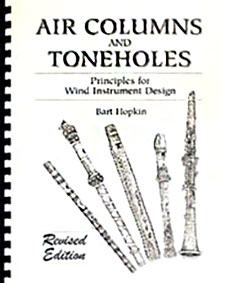Air Columns and Toneholes: Principles for Wind Instrument Design
By Bart Hopkin
42 pages, photocopied and spiral bound, 8-1/2″ x 11″, illustrated with charts, diagrams and drawings. Published by Tai Hei Shakuhachi, revised edition 1999.
A small book containing theory and how-to on woodwind instrument design as it relates to bore shape and tonehole sizing and placement.
The first section is devoted to wind instrument air columns. It discusses the acoustic behavior of air in conical tubes and cylindrical tubes, as well as variations on these shapes. Three-dimensional enclosures (as in vessel flutes or globular flutes) are discussed as well. The reader will learn the effects of air column shape on both fundamental pitch and overtone content.
The second section is devoted to tonehole sizing and placement: the art and science of determining where to place toneholes to produce particular pitches, and the effects of tonehole size and depth on tone quality.
Appendixes include a frequency and wavelength chart, a scales chart, lists of definitions and formulas, and a bibliography.
The book starts with a not-too-demanding generalist’s approach and works its way through to a more exacting mathematical approach. Non-mathematical readers who are interested in a more intuitive understanding may choose to read the generalist’s sections and bypass the more technical passages – they’ll still be able to get a lot out of the book. There is some overlap between this book and the book Musical Instrument Design, with some sections of the two texts covering similar information and about four illustrations in common, but Air Columns & Toneholes goes into considerably greater depth within its narrower subject area, and, for those who wish to tackle it, contains more exacting math. This edition has been reviewed, critiqued and corrected by the late Dr. John Coltman, one of the very foremost researchers in the field of woodwind acoustics.

